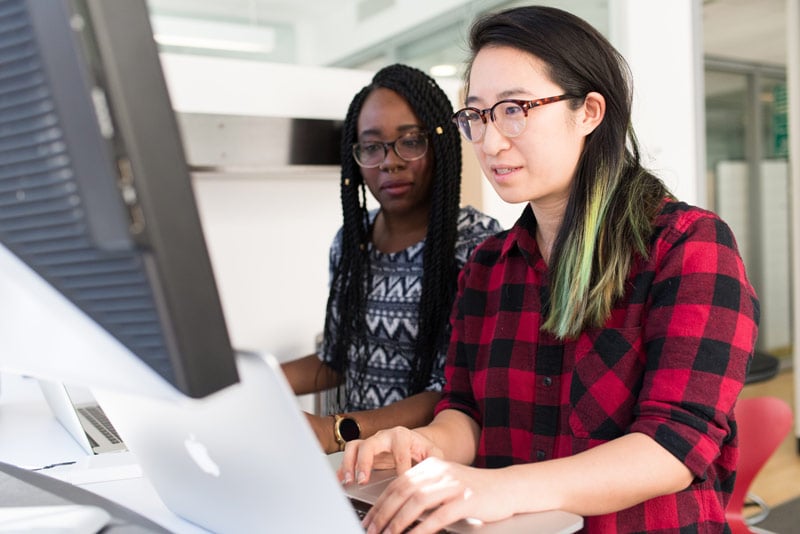Mediabrands & Kinesso: Creating a Culture of Inspired Inclusivity
IPG Mediabrands & Kinesso: Creating a Culture of “Inspired Inclusivity”
Interpublic Group (IPG) is a global provider of marketing solutions. Boasting $10 billion in annual revenue and approximately 56,800 employees in all major world markets, its companies specialize in advertising, digital marketing, communications planning, media, public relations, and specialty marketing. IPG describes itself as “values-focused, future-facing, and client-centric,” with an “intentional focus on ‘Inspired Inclusivity’” that helps to attract, retain, and develop the world’s best people.
Mediabrands and Kinesso, two of IPG’s companies, have worked closely with Percepytx to ensure that “Inspired Inclusivity” informs all aspects of their workplaces. Mediabrands – the media and marketing solutions division of IPG – and Kinesso – the “Marketing Engine of IPG’’ that delivers data-driven solutions through enhanced or newly-created products and services – used this partnership to elevate their DEI efforts to meet the demands of both clients and employees.

Talent Analytics and Employee Listening
Annalyn Jacob, Ph.D., Head of Talent Analytics and HR Operations for Mediabrands, was hired in 2020 to develop a talent analytics strategy that included establishing an expanded employee listening program. “We did have some employee listening before I joined, but my responsibility was to expand our employee listening program. We had our annual engagement survey that was run every other year, as well as our Culture of Inclusion survey run annually that was for all of the agencies under the IPG holding company umbrella, not just Mediabrands and Kinesso,” she said.
Perceptyx had already been working with IPG to administer those surveys, but Jacob wanted to go further. After Hermon Ghermay was hired as Mediabrands’ Global Chief Culture Officer, together with Renu Hooda, Kinesso’s Chief Talent Officer, they decided to start building a narrative around inclusion: “We wanted to understand what inclusion looks like for us and our culture, how we would define it, and then figure out how to support the development of an inclusive experience for our employees.”
Mediabrands and Kinesso also had diversity goals – hard numbers to achieve, not just survey results – for its top 10 markets, along with a multi-year timeline going through 2023 that is in the process of being revised because many markets, in Jacob’s words, “blew their goals out of the water.” But they also had markets that needed more support to get there, requiring recalibration from Jacob and her colleagues.
Because Mediabrands has a global presence, the diversity and representation goals vary from market to market. In Mexico and Australia, the company focused on indigenous talent. For India, the focus was on women. And in China, Mediabrands worked to increase the proportion of expatriates on the team.
“For a lot of our markets outside the United States, it’s about meeting representation goals,” Jacob explained. “In the United States, we didn’t have a representation goal. But we also had attraction goals, turnover goals, and promotion goals – with the assumption that if we accomplish those, then representation should naturally increase.”

The Inclusion Survey and the Inclusion Index
When Mediabrands and Kinesso worked with Perceptyx to develop its inclusion survey, the focus was placed on a few key areas. One part of the survey concerned experiences with managers and team members, as well as perceptions of executive leaders.
The survey also had four additional dimensions, which Mediabrands and Kinesso labeled its “four cornerstones.” “We believed that if we’re doing well in these four areas, we’re creating the foundation that would allow for an inclusive culture to emerge organically,” Jacob said.
Using the spring 2021 inclusion survey to set a baseline, Mediabrands and Kinesso created an Inclusion Index that enabled the companies to consistently measure their performance.
“It’s a 5-question index, capturing experiences with your manager, your team, your perceptions of leadership, and also the two true outcome measures of inclusion: uniqueness and belonging. Uniqueness refers to bringing your whole self to work, being yourself at work. Belonging is the sense that you’re part of this greater organization, that you belong here and have a place within this environment,” Jacob said.
Creating a Culture of “Inspired Inclusivity”
Improved performance in the area of inclusion demanded executive-level focus while the listening program that tracked it continued to evolve. Starting at the top, inclusion was a subject of great importance to Mediabrands Global CEO Daryl Lee and Kinesso Global CEO Arun Kumar.
“Our CEO, Daryl, is passionate about social justice and equal rights,” Jacob said. This was crucial because, per Jacob’s findings, “the softest area for us on the spring survey was that employees did not think leaders supported diversity and inclusion. They didn’t think leaders role-modeled behavior in that area. I think it took leadership by surprise, but when we ran the index again in the fall, that was our area of biggest improvement – the executive leadership question. It was dramatic.”
Part of the improvement came through listening sessions inspired by the spring survey, during which conversations, in Jacob’s words, “got real,” but also made a significant difference in changing the culture. “It became very personal for executive leadership, which is why they were able to make the progress that they made in just a few months.”
Ghermay laid the groundwork for this change. “When I came in, one of the things that Daryl really wanted was for us to bake inclusion into everything we do, rather than merely having DEI be a component of our work. So we said, ‘if leadership is the issue, what does leadership accountability look like?’ And ultimately what leadership accountability looked like was tying whatever goals we came up with to our leaders’ bonuses.”
Perceptyx, Ghermay said, helped build Mediabrands’ inclusion program, assisting with the identification of the five questions that comprised the Inclusion Index. “This index allowed us to track inclusion over time, letting us know that wherever we would see softness, we would have the benefit of a curriculum that was tied to the inclusion index – meaning we could reinforce what we saw in the data through education.”

Ghermay stressed that improvements in leadership performance on surveys do not mean that the leaders are somehow creating the culture by themselves. “A group of C-suite leaders cannot build a culture – it has to be co-created, and the people represented within it have to be just as much architects of it as we are. Our global definition of inclusion came from listening to our people. We talked to people to understand how we should actually talk about that. It’s more than just a buzzword.”
A culture of “Inspired Inclusivity” couldn’t have been built without listening this way. “If we only talked to leaders, the picture would be much rosier,” said Renu Hooda, the Global Chief Talent Officer for Kinesso since 2019. “So it was really important to start with those voices in order to drive change in the organization. We needed to know what our true baseline was.”
That meant working with Perceptyx to develop questions that would encourage employees to give candid feedback, Hooda explained. “We wanted to remove any biases in the questions, so we’ve been very direct and open with our employees so they can actually answer. We can text analyze some of the open comments they provide to see what themes are recurring. It was important to start with this survey so we can build on our baseline and continue measuring it because if it’s going downwards, we need to know what isn’t working. And if it’s going upwards, we need to know the good things we’re doing so we can build on them.”
DEI Drives the Business
For Mediabrands and Kinesso, inclusivity is a business necessity. In the highly diverse, global, and competitive space in which the companies operate, potential and existing clients with DEI goals of their own require information about the performance of the companies with which they work.
“Our clients ask us for feedback all the time because they want us to represent them with an inclusion mindset in our own business,” Renu Hooda said. “There wasn’t even a discussion about it. It was an ask that was put to our leaders, and they were like, ‘that makes perfect sense.’ We’re in the service industry. We have to be able to stand up there in front of clients and explain how we’re listening to our people and driving change in the organization.”
Mediabrands and Kinesso recognize that everything starts with the audience. “Well before we build a media plan, we always start by asking who is the audience, what do we know about them, and what is compelling or motivating for them? So we knew DEI was compelling for them and didn’t have to explain that step, plus we had leaders at the top who mandated this,” said Ghermay.
To ensure that employees understand how all of this is progressing, Kinesso and Mediabrands share findings from their quarterly surveys – sharing which in turn fosters greater employee participation in future surveys. Hooda underscored the importance of this back-and-forth dynamic: “Not only are we listening, but we’re hearing you and then taking that value coming out from your comments and applying it to our day-to-day interactions – and tying our leaders back to it, which gets people excited about it as well.”
Although the raw data and reporting remain with company leadership, Mediabrands’ and Kinesso’s global communications team shared those results with the wider organization. “We explained to people that this was part of a larger initiative and that it’s all linked, letting them know where we needed to do the work,” Ghermay said. “The leadership took that all on the chin, and to be honest, I didn’t expect things to shift so dramatically so quickly.”
The data-driven insights from the survey led directly to an extensive 6-hour session with executive leaders, during which Ghermay and Hooda ensured they understood what it meant to center the concept of inclusion in their work. The session, which had perfect attendance from company leadership, helped leaders understand where they needed to be more present and how they could support their employees.
“The 6-hour session was a game-changer for our leaders,” agreed Renu Hooda. “In previous times, we’d done an hour-long unconscious bias session for them. But this was really a self-reflection moment for them. Then we brought them into smaller groups, having discussions with their peers, and they had a number of ‘a-ha’ moments: ‘I’ve just been afraid to talk about race because I’m a white guy.’” This inclusion curriculum will remain in place, but Hooda and Ghermay said they intend to center the concept of belonging in their curriculum.
The Work of Continuous Improvement
As Mediabrands and Kinesso continue to grow, inclusion efforts will have to expand as well. The Inclusion Index and the inclusion curriculum will remain in place, but Hooda and Ghermay said they intend to center the concept of belonging in their curriculum.
“It will give people tools and strategies they need so they can talk about belonging, but how do we go about doing that? Well, as we see different scores fluctuate on the listening we do, we’ll be able to be a bit more clear on what we mean when we say this is acceptable behavior and that isn’t. Or whatever the various measures are. So I think we’ll always be calibrating that,” Ghermay said.
In other words, Ghermay explained, the listening data could be evaluated to focus on the experience of Black people in the United States or the United Kingdom or the experience of women in those areas. “If we start to see differences in those scores, we can begin using listening as a diagnostic tool. It can be a way for us to say, ‘hey, there’s something going on here with this group in this part of the world.’ So we’ll be able to continue to deepen the practice and start to have even more conversations. We’ve done the listening, we’ve had the curriculum, we’ve given people the language. The next phase is ‘let’s talk,’ because that’s something that doesn’t happen as often because we find ourselves a little bit uncomfortable coming at that. We’ll be able to create the space for people to come in and actually have conversations around these difficult topics.”
Challenges related to returning to the office, hybrid work, and remote work will also necessitate serious work on subjects such as inclusion and belonging. “For example, if there’s a hybrid meeting, we can still meet in a conference room together but have everyone there open up their laptops and mute themselves, so people who are remote can see everyone who is there,” said Renu Hooda.
Right-Sized Listening
With help from Perceptyx, Mediabrands and Kinesso also remain committed to listening at appropriate times and in the right formats. “We’re getting into the rhythm of listening, having earned our people’s trust regarding what we’re doing with this information,” said Ghermay. “But we are really trying to balance how much we survey and what about to prevent survey fatigue. The inclusion survey is run twice a year, with one being a full survey and the other an index tied to specific questions. We’ll continue to have that.
More than that, though, Ghermay and Hooda believe long-term listening will involve pulse surveying for regularly scheduled listening activities. “We need to understand the experience managers are creating for their people because even if leadership shows up in different ways, a manager who is making the employee experience difficult will impact your perception of working here.”
This listening will provide a better understanding of the areas where managers need additional training and upskilling. For both Mediabrands and Kinesso, special attention will be paid to first-time managers, who often assume these positions as a result of a promotion and may lack experience supervising others, as well as first-time leaders who are beginning to learn the difference between managing and leading.

Performance management is a priority, with the company already doing a 360-degree evaluation as part of its annual review process. Here, Renu Hooda explained, the real emphasis is on using performance enablement, enabling employees to grow within the company rather than merely having their performance assessed and managed. On top of that, both organizations are looking to do regular check-ins with employees to ensure they’re being heard – a critical need given the higher-than-average attrition experienced during the Great Resignation.
“We’re constantly digging in to see what’s been happening and what the trend is, what employees think about work-life balance and other factors that might cause them to leave the organization,” Jacob said. “We looked at changes on the exit survey around those areas, and we launched an onboarding survey in January and we’re still getting data in for that. We’ve seen that our pre-pandemic system of assigning ‘buddies’ who help you navigate the workplace needs to be revamped to meet post-pandemic needs, since it’s not working quite the same way.”
Partnering with Perceptyx
As Mediabrands and Kinesso worked with Perceptyx on listening issues, leadership at the two organizations saw clear advantages to the partnership.
“We set up time to talk with (Perceptyx) consultants to say, all right, help us avoid pitfalls,” Jacob said. “And they spent a lot of time walking through that with us. We explained our needs and approach, our need for a cohesive message, but more importantly our baseline and benchmarks for the listening we were going to do because this was the first time we were doing it.”
Perceptyx’s consultants provided strategic advice about messaging as well as essential tactical guidance about the development of benchmarks and their implications for the future. “They dealt with things like, how would you even set a goal in an area if you’re at 85% already,” explained Jacob. “How would that even work for your next goal? Are you going to ask people to go up to 90%?”
Perceptyx’s team partnered closely with leadership at Mediabrands and Kinesso to work through these issues, ensuring that executives felt a sense of ownership about the listening program that resulted.
“Even now, after we’ve changed the inclusion survey a little, your consultants continued making important suggestions, offering feedback like ‘all right, if this is what you’re going for, these are some things you might want to focus on.’ And we’ve ended up adding things like psychological safety to our survey, which we didn’t have before, but it made sense given the context and the progress we’ve made together. The ability to make small adjustments as we go has been really helpful because our program hasn’t been around for very long, given that we only started in 2020,” said Jacob.
Most importantly, Jacob explained, Perceptyx has been there at every step of the listening journey for Mediabrands and Kinesso. “We’re building the culture as we build the tools, and Perceptyx’s experience has been really helpful throughout the process.”
Want to learn more?

About Interpublic Group (IPG) & Mediabrands
Founded: IPG was founded in 1930 as McCann-Erickson, from a merger of H.K. McCann Co. and Erickson Co. Mediabrands, a division of IPG, manages approx. $40B in marketing investments globally on behalf of clients through both its full-service agency networks and its award-winning specialty business units.
Industry: Marketing and advertising solutions
Corporate Headquarters: New York City, NY
Employees: 56,800
Revenue (2021): $9.1 billion
Website: www.interpublic.com | www.ipgmediabrands.com
Customer Success Snapshot
The Challenge:
- Develop a listening program that supports “Inspired Inclusivity” and informs the DEI mission of Mediabrands and Kinesso
- Create an Inclusion Index to provide actionable, ongoing insights into inclusion efforts
- Continue to fine-tune listening efforts to support pulse surveys and the ongoing expansion of the listening program
The Solution:
- An annual inclusion survey with questions designed to capture the voices of employees
- A follow-up survey that checks progress against the items that make up the Inclusion Index
- Information that could be utilized by leadership and shared in summary form with 15,000 employees to effect transformative change related to inclusion
The Outcomes:
- Leadership used seminars, training, and insights from the listening program to dramatically improve employee perceptions of their performance
- HR could begin to shift focus to other areas, such as an emphasis on belonging, that have considerable impact in the post-pandemic workplace
- Perceptyx continues to partner with Mediabrands and Kinesso to analyze progress toward benchmarks, refine questions put to employees, and expand the scope of the listening program in areas such as talent recruitment/retention and performance management